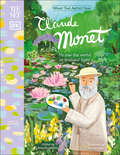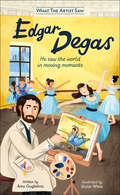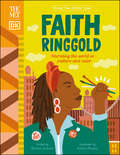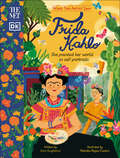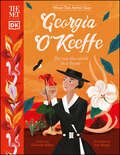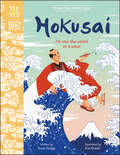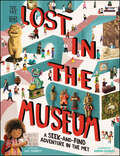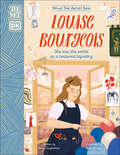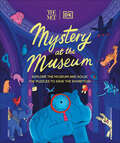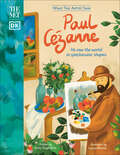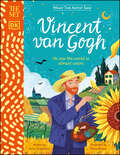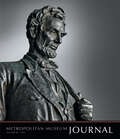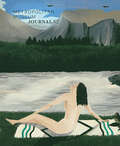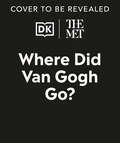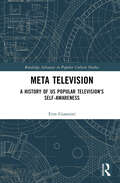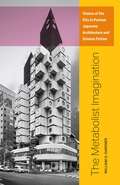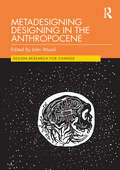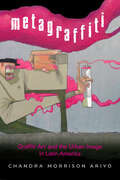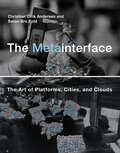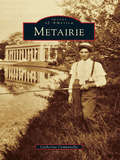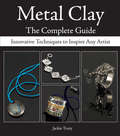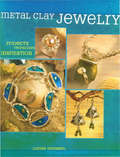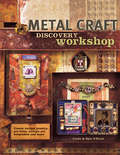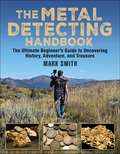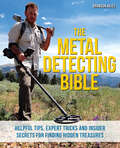- Table View
- List View
The Met Claude Monet: He Saw the World in Brilliant Light (What the Artist Saw)
by Amy GuglielmoSee how iconic artists like Claude Monet were influenced by their environments in this beautiful series produced in collaboration with The Met.See the world through Claude Monet&’s&’ eyes and be inspired to produce your own masterpieces. Have you ever wondered exactly what your favorite artists were looking at to make them draw, sculpt, or paint the way they did? In this charming illustrated series of books to keep and collect, created in full collaboration with the Metropolitan Museum of Art, you can see what they saw and be inspired to create your own artwork, too. In What the Artist Saw: Claude Monet, meet famous French painter Claude Monet. Step into his life and learn how he pioneered the Impressionist movement. Learn all about his love of nature and how he was inspired to paint light, water, and water lilies. Have a go at producing your own art inspired by what you find most beautiful about nature! In this series, follow the artists&’ stories and find intriguing facts about their environments and key masterpieces. Then see what you can see and make your own art. Take a closer look at landscapes, or even yourself, with Vincent van Gogh. Try crafting a story in fabric like Faith Ringgold, or carve a woodblock print at home with Hokusai. Every book in this series is one to treasure and keep— perfect for budding young artists to explore exhibitions with, then continue their own artistic journeys.
The Met Edgar Degas: He Saw the World in Moving Moments (What the Artist Saw)
by Amy GuglielmoSee how iconic artists like Edgar Degas were influenced by their environments in this beautiful series produced in collaboration with The Met.See the world through Edgar Degas&’s eyes and be inspired to produce your own masterpieces.Have you ever wondered exactly what your favorite artists were looking at to make them draw, sculpt, or paint the way they did? In this charming illustrated series of books to keep and collect, created in full collaboration with The Metropolitan Museum of Art, you can see what they saw, and be inspired to create your own artworks, too. In What the Artist Saw: Edgar Degas, meet the famous French painter and sculptor. Learn all about how he broke new ground and captured the energy and elegance of skilled ballet dancers.In this series, follow the artists&’ stories and find intriguing facts about their environments and key masterpieces. Then see what you can see and make your own art. Take a closer look at landscapes, or even yourself, with Vincent van Gogh. Try crafting a story in fabric like Faith Ringgold, or carve a woodblock print at home with Hokusai. Every book in this series is one to treasure and keep—perfect for budding young artists to explore exhibitions with then continue their own artistic journeys.
The Met Faith Ringgold: Narrating the World in Pattern and Color (What the Artist Saw)
by Sharna JacksonSee the world through Faith Ringgold's eyes and be inspired to produce your own masterpieces.Have you ever wondered exactly what your favorite artists were looking at to make them draw, sculpt, or paint the way they did? In this charming illustrated series of books to keep and collect, created in full collaboration with the Metropolitan Museum of Art, you can see what they saw, and be inspired to create your own artworks, too. In What the Artist Saw: Faith Ringgold, meet inspiring American activist Faith Ringgold. Step into her life and learn what led her to mix different media and craft powerful stories into quilts. Travel with her from Harlem, New York, to Europe, Ghana, and Nigeria. Pick a cause that you care about and try combining it with fabric or sculpture to make your own artworks! In this series, follow the artists' stories and find intriguing facts about their environments and key masterpieces. Then see what you can see and make your own art. Take a closer look at landscapes with Georgia O'Keeffe, or even yourself, with Vincent van Gogh. Try carving a woodblock print at home with Hokusai. Every book in this series is one to treasure and keep: perfect for budding young artists to explore exhibitions with, and then continue their own artistic journeys.
The Met Frida Kahlo: She Painted Her World in Self-Portraits (What the Artist Saw)
by Amy GuglielmoSee the world through Frida Kahlo's eyes and be inspired to produce your own masterpieces.Have you ever wondered exactly what your favorite artists were looking at to make them draw, sculpt, or paint the way they did? In this charming illustrated series of books to keep and collect, created in full collaboration with The Metropolitan Museum of Art, you can see what they saw, and be inspired to create your own artworks, too. In What the Artist Saw: Frida Kahlo, meet the famous Mexican painter. Learn all about how she experimented with different ways of painting herself, and how she channeled her experiences into her art. Have a go at producing your own self portrait!In this series, follow the artists' stories and find intriguing facts about their environments and key masterpieces. Then see what you can see and make your own art. Take a closer look at landscapes, or even yourself, with Vincent van Gogh. Try crafting a story in fabric like Faith Ringgold, or carve a woodblock print at home with Hokusai. Every book in this series is one to treasure and keep - perfect for budding young artists to explore exhibitions with, then continue their own artistic journeys.© The Metropolitan Museum of Art, New York
The Met Georgia O'Keeffe: She saw the world in a flower (What the Artist Saw)
by Gabrielle BalkanSee the world through Georgia O'Keeffe's eyes and be inspired to produce your own masterpieces.Have you ever wondered exactly what your favorite artists were looking at to make them draw, sculpt, or paint the way they did? In this charming illustrated series of books to keep and collect, created in full collaboration with the Metropolitan Museum of Art, you can see what they saw, and be inspired to create your own artworks, too. In What the Artist Saw: Georgia O'Keeffe, meet famous American painter Georgia O'Keeffe. Step into her life and learn what led her to look closely at nature and paint her iconic paintings of flowers and bones. See the vast New Mexico landscapes that inspired her work. Have a go at producing your own close-up still-life artworks! Follow the artists' stories and find intriguing facts about their environments and key masterpieces. Then see what you can see and make your own art. Take a closer look at landscapes, or even yourself, with Vincent van Gogh. Try crafting a story in fabric like Faith Ringgold, or carve a woodblock print at home with Hokusai. Every book in this series is one to treasure and keep - perfect for budding young artists to explore exhibitions with, then continue their own artistic journeys. © The Metropolitan Museum of Art, New York
The Met Hokusai: He Saw the World in a Wave (What the Artist Saw)
by Susie HodgeSee the world through Hokusai's eyes and be inspired to produce your own masterpieces.Have you ever wondered exactly what your favorite artists were looking at to make them draw, sculpt, or paint the way they did? In this charming illustrated series of books to keep and collect, created in full collaboration with The Metropolitan Museum of Art, you can see what they saw, and be inspired to create your own artworks, too. In What the Artist Saw: Hokusai, meet groundbreaking Japanese artist Hokusai. Step into his life and learn what led him to create more than 30,000 works of art, including his famous woodcut views of The Great Wave off Kanagawa and Mount Fuji. Discover how he planned to live to 110 and even produced the first ever pieces of manga! Have a go at making your own printed artworks. In this series, follow the artists&’ stories and find intriguing facts about their environments and key masterpieces. Then see what you can see and make your own art. Take a closer look at landscapes with Georgia O&’Keeffe, or even yourself, with Vincent van Gogh. Every book in this series is one to treasure and keep – perfect for inspiring budding young artists to continue their own artistic journeys. © The Metropolitan Museum of Art, New York
The Met Lost in the Museum: A seek-and-find adventure in The Met (DK The Met)
by Will MabbittA visually stunning seek-and-find museum adventure for inquisitive kids.Seven-year-old Stevie is lost in the galleries! She needs to locate a series of artworks to find her way out and back to her family. Can you help her? Follow Stevie as she explores the most exciting and intriguing galleries and exhibitions inside The Met in this beautifully illustrated seek-and-find adventure!As Stevie moves through The Met's galleries of Greek and Roman art, Ancient Egypt, and Modern and Contemporary art, learn about the rarest and most beautiful objects found in the museum's prestigious galleries. Who can you find? What will you discover?© The Metropolitan Museum of Art, New York
The Met Louise Bourgeois: She Saw the World as a Textured Tapestry (What the Artist Saw)
by Amy GuglielmoSee how iconic artists like Louise Bourgeois were influenced by their environments in this beautiful series produced in collaboration with The Met.See the world through Louise Bourgeois&’s eyes and be inspired to produce your own masterpieces. Have you ever wondered exactly what your favorite artists were looking at to make them draw, sculpt, or paint the way they did? In this charming illustrated series of books to keep and collect, created in full collaboration with the Metropolitan Museum of Art, you can see what they saw and be inspired to create your own artworks too. In What the Artist Saw: Louise Bourgeois, meet famous French American painter, printmaker, and sculptor Louise Bourgeois. Step into her life and learn what led her to explore her fears and emotions through her art. Learn all about her family and what inspired her to create her large spider sculptures. Have a go at producing your own art inspired by your dreams! In this series, follow the artists&’ stories and find intriguing facts about their environments and key masterpieces. Then see what you can see and make your own art. Take a closer look at landscapes, or even yourself, with Vincent van Gogh. Try crafting a story in fabric like Faith Ringgold, or carve a woodblock print at home with Hokusai. Every book in this series is one to treasure and keep— perfect for budding young artists to explore exhibitions with, then continue their own artistic journeys.
The Met Mystery at the Museum: Explore the Museum and Solve the Puzzles to Save the Exhibition! (DK The Met)
by Helen FrielJoin William the hippo and friends in an interactive adventure puzzle book. Help them solve the mystery and save the exhibition!William the hippo and his friends live on 5th Avenue, New York, inside the Metropolitan Museum of Art. At night, when the museum is closed and all the visitors have gone home, their adventures begin. A special exhibition is about to open, and everyone is excited to see the amazing exhibits from all over the world. However, the boxes holding the exhibits are locked with puzzles that need to be solved. The curators are struggling to figure them out - it's up to you to help William and his friends travel through the museum, solve the puzzles, and save the exhibition!
The Met Paul Cézanne (What the Artist Saw)
by Amy GuglielmoSee the world through Paul Cézanne's eyes and be inspired to produce your own masterpieces.Have you ever wondered exactly what your favorite artists were looking at to make them draw, sculpt, or paint the way they did? In this charming illustrated series of books to keep and collect, created in full collaboration with The Metropolitan Museum of Art, you can see what they saw and be inspired to create your own artworks, too. In What the Artist Saw: Paul Cézanne meet the famous French painter. In this series, follow the artists' stories and find intriguing facts about their environments and key masterpieces. Then see what you can see and make your own art. Take a closer look at landscapes, or even yourself, with Vincent van Gogh. Try crafting a story in fabric like Faith Ringgold, or carve a woodblock print at home with Hokusai. Every book in this series is one to treasure and keep-perfect for budding young artists to explore exhibitions with, then continue their own artistic journeys.
The Met Vincent van Gogh: He saw the world in vibrant colors (What the Artist Saw)
by Amy GuglielmoSee the world through Vincent van Gogh's eyes and be inspired to produce your own masterpieces.Have you ever wondered exactly what your favorite artists were looking at to make them draw, sculpt, or paint the way they did? In this charming illustrated series, created in full collaboration with the Metropolitan Museum of Art, you can see what they saw, and be inspired to create your own artworks, too. In the pages of this book, What the Artist Saw: Vincent van Gogh, meet famous Dutch painter Vincent van Gogh. Step into his life and learn what led him to paint his eye-catching self-portraits. See the landscapes that inspired his famous Wheat Fields. Have a go at painting your own sunflowers! Follow the artists' stories and find intriguing facts about their environments and key masterpieces. Then see what you can see and make your own art. Take a closer look at nature with Georgia O'Keeffe. Try crafting a story in fabric like Faith Ringgold, or carve a woodblock print at home with Hokusai. Every book in this series is one to treasure and keep - the perfect gift for budding artists to explore exhibitions with, then continue their own artistic journeys. © The Metropolitan Museum of Art, New York
MET vol 48 num 1
by The University of Chicago PressThis is volume 48 issue 1 of Metropolitan Museum Journal. Founded in 1968, the Metropolitan Museum Journal is a blind, peer-reviewed scholarly journal published annually that features original research on the history, interpretation, conservation, and scientific examination of works of art in the Museum’s collection. Its scope encompasses the diversity of artistic practice from antiquity to the present day. The Journal encourages contributions offering critical and innovative approaches that will further our understanding of works of art.
MET vol 52 num 1
by The University of Chicago PressThis is volume 52 issue 1 of Metropolitan Museum Journal. Founded in 1968, the Metropolitan Museum Journal is a blind, peer-reviewed scholarly journal published annually that features original research on the history, interpretation, conservation, and scientific examination of works of art in the Museum’s collection. Its scope encompasses the diversity of artistic practice from antiquity to the present day. The Journal encourages contributions offering critical and innovative approaches that will further our understanding of works of art.
The Met Where Did Van Gogh Go? (DK The Met)
by DKLose yourself in scenes inspired by the creative genius of Vincent Van Gogh, Georgia O’Keeffe, Hokusai, James Van Der Zee, and many more!Do you want to roam through a field of swaying cypress trees hunting for Vincent Van Gogh’s paintbrush? Or explore Georgia O’Keeffe’s New Mexico ranch on the lookout for wildflowers? Perhaps you’d rather navigate the waterways of Canaletto’s Venice to find decorative masks?Discover unique scenes inspired by some of The Metropolitan Museum of Art’s most loved paintings and the lives of their creators. Read about the artist and their work before embarking on a fun seek-and-find activity inspired by the artist’s life.Perfect for fans of Where’s Waldo? and Pierre the Maze Detective, Where Did Van Gogh Go? is the arty spotting book that little kids and big kids alike can enjoy.
Meta Television: A History of US Popular Television's Self-Awareness (Routledge Advances in Popular Culture Studies)
by Erin GianniniThe idea of metatextuality is frequently framed as a recent television development and often paired with the idea that it represents genre exhaustion. US television, however, with its early “live” performances and set-bound sitcoms, always suggested an element of self-awareness that easily shaded into metatextuality even in its earliest days. Meta Television thus traces the general history of US television’s metatextuality throughout television’s history, arguing that TV’s self-awareness is nothing new—and certainly not evidence of a period of aesthetic exhaustion—but instead is woven into both its past and present practice, elucidated through case studies featuring series from the 1970s to the present day—many of which have not been critically analyzed before—and the various ways they deploy metatext to both construct and deconstruct their narratives. Further, Meta Television asserts that this re- and de-construction of narrative and production isn’t just a reward to the savvy and/or knowledgeable viewer (or consumer), but seeks to make broader points about the media we consume—and how we consume it.This book explores the ways in which the current metatextual turn, in both the usual genres in which it appears (horror and sci-fi/fantasy) and its movement into drama and sitcom, represents the next turn in television’s inherent self-awareness. It traces this element throughout television’s history, growing from the more modest reflexivity of programs’ awareness of themselves, as created objects in a particular medium, to the more significant breaking of the fictive illusion and therefore the perceived distance between the audience and the series. Erin Giannini shows how the increased currency of metatextual television in the contemporary era can be tied to a viewership well-versed in its stories and production as well as able and willing to “talk back” via social media. If television reflects culture to a certain extent, this increased reflexivity mirrors that “responsive” audience as a consequence of the lack of distance that metafiction embraces.As Robert Stam traced the use—and implications—of reflexivity in film and literature, this book does the same for television, further problematizing John Ellis’s glance theory in terms of both production and spectatorship.
The Metabolist Imagination: Visions of the City in Postwar Japanese Architecture and Science Fiction
by William O. GardnerJapan&’s postwar urban imagination through the Metabolism architecture movement and visionary science fiction authors The devastation of the Second World War gave rise to imaginations both utopian and apocalyptic. In Japan, a fascinating confluence of architects and science fiction writers took advantage of this space to begin remaking urban design. In The Metabolist Imagination, William O. Gardner explores the unique Metabolism movement, which allied with science fiction authors to foresee the global cities that would emerge in the postwar era.This first comparative study of postwar Japanese architecture and science fiction builds on the resurgence of interest in Metabolist architecture while establishing new directions for exploration. Gardner focuses on how these innovators created unique versions of shared concepts—including futurity, megastructures, capsules, and cybercities—making lasting contributions that resonate with contemporary conversations around cyberpunk, climate change, anime, and more.The Metabolist Imagination features original documentation of collaborations between giants of postwar Japanese art and architecture, such as the landmark 1970 Osaka Expo. It also provides the most sustained English-language discussion to date of the work of Komatsu Sakyō, considered one of the &“big three&” authors of postwar Japanese science fiction. These studies are underscored by Gardner&’s insightful approach—treating architecture as a form of speculative fiction while positioning science fiction as an intervention into urban design—making it a necessary read for today&’s visionaries.
Metadesigning Designing in the Anthropocene (Design Research for Change)
by John WoodLong-sighted, radical and provocative, this book offers a foundational framework of concepts, principles and methods (exemplified with selected tools) to enable metadesigners to manage and reinvent their practices. The book reminds readers that designers are, albeit unwittingly, helping to shape the Anthropocene. Despite their willingness to deliver greener products and services, designers find themselves part of an industry that has become the go-to catalyst for dividends and profit. If our species is to achieve the rehabilitation and metamorphosis, we may need to design at the level of paradigms, genres, lifestyles and currencies. This would mean making design more integrated, comprehensive, adaptive, transdisciplinary, self-reflexive and relational. The book, therefore, advocates a shift of emphasis from designing ‘sustainable’ products, services and systems towards cultivating synergies that will induce regenerative lifestyles. The book will be of interest to managers, designers, scholars and educators from a wide range of backgrounds, including design research, design history, design studies and environmental studies.
Metagraffiti: Graffiti Art and the Urban Image in Latin America
by Chandra Morrison AriyoFocusing on graffiti scenes from São Paulo and Santiago in Chile, this innovative visual ethnography examines diverse forms of self-reference and metareference that appear in Latin American graffiti art. Chandra Morrison Ariyo works across multiple scales of contemporary graffiti production—from tags to massive murals—to show how painting the city enables individuals to reimagine their own position within the material and social structures around them. Metagraffitti reveals how practitioners such as Tinho, OSGEMEOS, Grin, and Bisy use metagraffiti features to influence public perceptions about this art form and its effect on the urban environment. Ultimately, Metagraffiti proposes a novel conceptual framework that highlights graffiti’s ability to forge alternative forms of movement, sociality, and value within Latin American cityscapes. These urban images invite us to imagine what the city could be, when seen as a site for action and imagination.
The Metainterface: The Art of Platforms, Cities, and Clouds (The\mit Press Ser.)
by Christian Ulrik Andersen Soren Bro PoldHow the interface has moved from the PC into cultural platforms, as seen in a series of works of net art, software art and electronic literature.The computer interface is both omnipresent and invisible, at once embedded in everyday objects and characterized by hidden exchanges of information between objects. The interface has moved from office into culture, with devices, apps, the cloud, and data streams as new cultural platforms. In The Metainterface, Christian Ulrik Andersen and Søren Bro Pold examine the relationships between art and interfaces, tracing the interface's disruption of everyday cultural practices. They present a new interface paradigm of cloud services, smartphones, and data capture, and examine how particular art forms—including net art, software art, and electronic literature—seek to reflect and explore this paradigm.Andersen and Pold argue that despite attempts to make the interface disappear into smooth access and smart interaction, it gradually resurfaces; there is a metainterface to the displaced interface. Art can help us see this; the interface can be an important outlet for aesthetic critique. Andersen and Pold describe the “semantic capitalism” of a metainterface industry that captures user behavior; the metainterface industry's disruption of everyday urban life, changing how the city is read, inhabited, and organized; the ways that the material displacement of the cloud affects the experience of the interface; and the potential of designing with an awareness of the language and grammar of interfaces.
Metairie (Images of America)
by Catherine CampanellaMetairie was the first suburb of New Orleans; an outgrowth to the west by young families seeking larger lots, open air, and affordable new housing. Those suburbanites shared much in common with previous generations of New Orleanians who had migrated westward from the original town (now the French Quarter) to high land along the Mississippi River and the Metairie Ridge. When Jefferson Parish was established in 1825, it included all New Orleans faubourgs west of Felicity Street--what we now know as Uptown New Orleans. These would become the first cities in Jefferson Parish: Carrolton, Jefferson, and Lafayette. By the early 1900s, the westward expansion continued into what we now call Old Metairie and Bucktown. During the mid-20th century, Metairie boomed and is now one of the largest communities in Louisiana. While many residents consider themselves New Orleanians, even those born generations after their families moved to the suburb, Metairie has its own unique history.
Metal Clay The Complete Guide: Innovative Techniques to Inspire Any Artist
by Jackie TrutyExplore Metal Clay from Package to Project Metal clay's versatility and ability to be enhanced by every other known medium has broadened design possibilities for artists everywhere. Metal Clay The Complete Guideis the reference book every metal clay artist needs to have on the shelf for quick access to how-to information on a variety of subjects, including: Materials and tools for working with metal clay Metal clay care and handling, including tips for keeping your clay from drying out Techniques including rolling, adding texture, stamping, lids and forming How-tos for shaping bails, loops, beads and connectors Mixing metal clay with glass, enamels, beads, gemstones and more Tips and troubleshooting Four projects: bracelets, lentil bead, box pendant, ring Helpful appendices, including ring sizing, gemstone firing times, drying times, kiln firing temperatures and alternative firing methods Whether you are just getting started or have been working with metal clay or related materials for years,Metal Clay The Complete Guideis guaranteed to be the resource you turn to the most.
Metal Clay Jewelry: Projects. Techniques. Inspirations.
by Louise DuhamelExplore the endless possibilities of metal clay Sculpt it, cut it, shape it, roll it. Just about anything is possible when you're creating with the amazing medium of metal clay. Whether you're new to its wonders or are looking for new ideas and techniques, Metal Clay Jewelry has it all. Metal clay artist and instructor Louise Duhamel starts with the basics of the medium explaining the different forms of clay and teaching the basic techniques. Then the fun really begins! In twenty projects created by Louise and other talented clay artists, you'll learn more fabulous techniques including origami folding with paper clay, sculpting with paste clay, enameling, creating hollow forms and so much more. With step-by-step photography throughout, you won't miss a beat as you explore this amazing medium. In addition, with variation projects and a gallery of stellar art by world-renown artists, you get all the inspiration you'll need to start designing your own metal clay pieces. Discover all the possibilities of metal clay today!
Metal Craft Discovery Workshop: Create Unique Jewelry, Art Dolls, Collage Art, Keepsakes And More!
by Opie O'Brien Linda O'BrienCreating with metal has never been easier!Whether it's jewelry, journals or kitschy keepsakes that spark your fire, Metal Craft Discovery Workshop shows just how easy it is to create 20 fun and funky projects step-by-step, from a miniature journal to an altered lunch box.A nontraditional approach and a comprehensive techniques section will introduce you to the whimsical side of metal. Not only will you learn secrets to cutting and joining metal, you'll also:Explore ways to age and add texture to metalDiscover the numerous types of metal available, including copper, mesh, wire and recycled materialConjure up beautiful patina finishes with several "secret" recipesFind further inspiration in the artists' gallery sectionYou'll love creating these pieces, whether you've worked with metal before or you're new to the medium. Give your recycle bin a second glance and start crafting beautiful pieces with metal today.
Metal Detecting: The Ultimate Beginner's Guide to Uncovering History, Adventure, and Treasure
by Mark SmithEnthusiastic, thorough, and everything you need to know about discovering buried treasure!There is an incredible amount of treasure buried right under our feet, but most people don't even know this huge amount of untold wealth exists. Imagine how it must feel to uncover large caches of silver and gold coins or long-lost jewelry packed with shimmering, precious stones. These are not some made-up fairy tales-there are people who, at this very moment, are finding these treasures.Veteran metal detector and treasure hunter Mark Smith takes you under his wing and demystifies treasure hunting in Metal Detecting by revealing his most closely guarded secrets and sharing personal stories of success. These valuable lessons and truly amazing treasure hunting stories will make you wonder why you aren't out there with a metal detector right now!Metal Detecting cuts right through the technical jargon and spells everything out with full-color illustrations and easy-to-understand terms, making this book simple to follow, regardless of your prior treasure-hunting experience. Novices and seasoned veterans will both find plenty of helpful information buried in the pages of this book-from choosing your first metal detector to finding locations loaded with unlimited treasure possibilities, and everything in between. Mark shows you how to get out there and claim your own share of treasure, be it gold, silver, meteorites, old coins, jewelry, or relics. What are you waiting for? Grab a copy today and start uncovering history, adventure, and treasure!
The Metal Detecting Bible: Helpful Tips, Expert Tricks And Insider Secrets For Finding Hidden Treasures
by Brandon NeiceTHE ULTIMATE A-TO-Z GUIDE REVEALING EVERYTHING YOU NEED TO KNOW TO BECOME A METAL DETECTING EXPERT Nothing is as thrilling as finding cool (and often valuable) stuff right under your feet. So grab this guide and get ready to dig up more and more finds. Packed with helpful information on making your search successful and exciting, The Metal Detecting Bible serves up step-by-step instructions, illustrations, and useful photos that can turn you into a professional treasure hunter. From quick-start tips for novices to insider secrets for the most experienced hobbyists, this hands-on guide is the ultimate resource on all aspects of metal detecting. *Choose the best metal detector *Learn where to search and why *Practice appropriate swing techniques *Integrate advanced GPS technology *Scout out beaches, parks and historic sites *Gain permission to hunt on private property *Identify antique coins, relics and jewelry *Use handy target recovery tools *Clean and safely preserve your finds *Sell your finds for a profit
